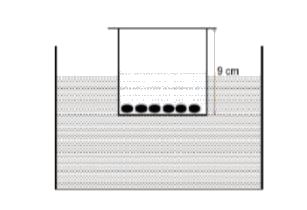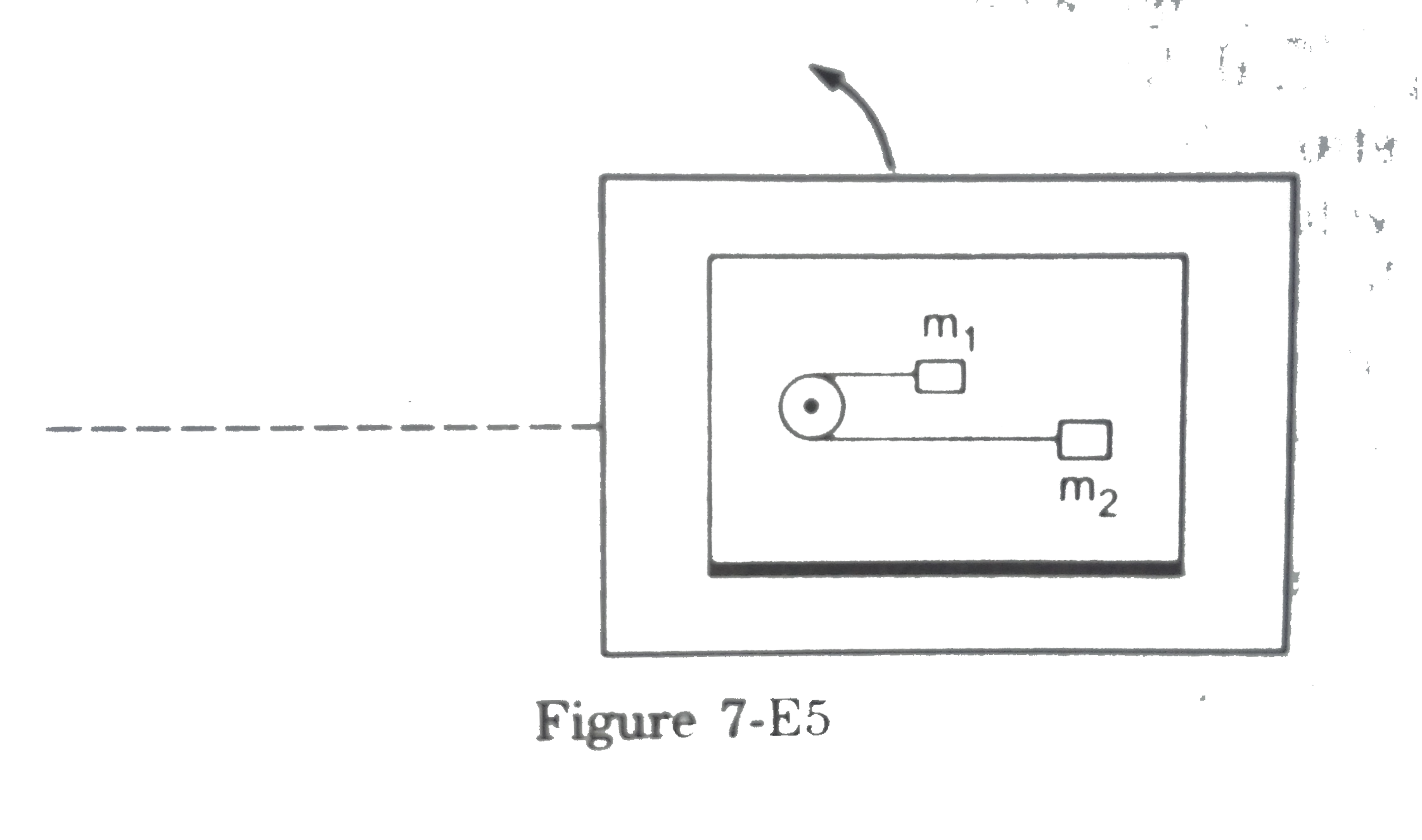A narrow but tall cabin is falling freely near the earth's surface. Inside the cabin, two small stones A and B are released from rest (relative to the cabin). Initially A is much above the centre of mass and B much below the centre of mass of the cabin. A close observation of the motion of A and B will reveal that -
both A and B continue to be exactly at rest relative to the cabin
A moves slowly upward and B moves slowly downward relative to the cabin
both A and B fall to the bottom of the cabin with constant acceleration due to gravity
A and B move slightly towards each other vertically
The correct Answer is:B
To solve the problem, we need to analyze the situation of the falling cabin and the stones A and B inside it.
1. Understanding the System:
- The cabin is falling freely under the influence of gravity, which means it is in free fall.
- Inside the cabin, two stones A and B are released from rest relative to the cabin.
2. Position of Stones:
- Stone A is positioned much above the center of mass of the cabin.
- Stone B is positioned much below the center of mass of the cabin.
3. Acceleration of the Cabin:
- Since the cabin is in free fall, it has an acceleration equal to the acceleration due to gravity (g) directed downwards.
4. Relative Motion of Stones:
- When stones A and B are released, they are initially at rest relative to the cabin. However, due to their positions relative to the center of mass of the cabin, their accelerations will differ from that of the cabin.
- Stone A, being above the center of mass, will experience a slightly lesser gravitational pull compared to the cabin, while stone B, being below the center of mass, will experience a slightly greater gravitational pull.
5. Acceleration Comparison:
- The acceleration of stone A (let's denote it as aA) will be less than the acceleration of the cabin (denoted as aCM).
- The acceleration of stone B (denote it as aB) will be greater than aCM.
- Therefore, we have:
aA<aCM<aB
6. Relative Motion:
- Since stone A has a lesser downward acceleration, it will appear to move upwards relative to the cabin.
- Conversely, stone B, having a greater downward acceleration, will appear to move downwards relative to the cabin.
7. Conclusion:
- As a result, stone A moves slowly upward and stone B moves slowly downward relative to the cabin.
Final Answer:
- The correct observation is: A moves slowly upward and B moves slowly downward relative to the cabin.
- The cabin is falling freely under the influence of gravity, which means it is in free fall.
- Inside the cabin, two stones A and B are released from rest relative to the cabin.
- Stone A is positioned much above the center of mass of the cabin.
- Stone B is positioned much below the center of mass of the cabin.
- Since the cabin is in free fall, it has an acceleration equal to the acceleration due to gravity (g) directed downwards.
- When stones A and B are released, they are initially at rest relative to the cabin. However, due to their positions relative to the center of mass of the cabin, their accelerations will differ from that of the cabin.
- Stone A, being above the center of mass, will experience a slightly lesser gravitational pull compared to the cabin, while stone B, being below the center of mass, will experience a slightly greater gravitational pull.
- The acceleration of stone A (let's denote it as aA) will be less than the acceleration of the cabin (denoted as aCM).
- The acceleration of stone B (denote it as aB) will be greater than aCM.
- Therefore, we have:
aA<aCM<aB
- Since stone A has a lesser downward acceleration, it will appear to move upwards relative to the cabin.
- Conversely, stone B, having a greater downward acceleration, will appear to move downwards relative to the cabin.
- As a result, stone A moves slowly upward and stone B moves slowly downward relative to the cabin.
- The correct observation is: A moves slowly upward and B moves slowly downward relative to the cabin.
Topper's Solved these Questions
Similar Questions
A wide bottom cylindrical massless plastic container of height 9 cm has 40 identical coins inside it and is floating on water with 3 cm inside the water. If we start putting more of such coins on its lid. It is observed that after N coins are put, its equilibrium changes from stable to unstable. Equilibrium in floating is stable if the geometric center of the submerged portion is above the center of mass of the object) The value of N is closed to
 04:28View Solution
04:28View SolutionA table with smooth horizontal surface is placed in a cabin which moves in a circle of a large radius R Figure. A smooth pulley of small radius is fastened to the table. Two masses m and 2m placed on te tableare connected through a string going over the pulley. Initially the masses are held by a personwith the strings aslong teh outward radius and then the system is released from rest (with respect to the cabin). Find the magnitude of the initial acceleration of the mases as seen from the cabin and the tension in the starting.
 02:14View Solution
02:14View SolutionAssertion: A man in a dosed cabin falling freely does not experience gravity. Reason: Inertial and gravitational mass have equivalence.
03:43View SolutionA body is dropped from the celling of a transparent cabin falling freely towards the earth . Describe the motion of the body as observed by an observer (a) sitting in the cabin (b) standing on earth.
01:44View SolutionSTATEMENT-1 : Time periodof oscillation of a simple pendulum mounted in a cabin that is freely falling is zero and STATEMENT -2 , In the cabin falling freely under gravity the pendulum is in state of weightlessness.
01:54View Solutionएक केबिन में लटके लोलक की आवृत्ति क्या होगी, जब स्वतंत्रतापूर्वक गिर रहा हो?
02:17View SolutionAnswer the following questions:
(a) The motion of a simple pendulum is approximately simple harmonic for small angle oscillation. For larger angles of oscilliation, a more involved analysis shows that T is greater than 2π√tg Think of a qualitative argument to appreciate this result.
(b) What is the frequency of oscillation of a simple pendulum mounted in a cabin that is freely falling under gravity ?02:22View Solutionपृथ्वी की ओर स्वतंत्रतापूर्वक गिरते हुए एक पारदर्शी केबिन की छत से एक पिण्ड छोड़ दिया जाता है। एक प्रेक्षक को पिण्ड की गति किस प्रकार की प्रतीत होगी यदि वह (i) केबिन में बैठा हो (ii) पृथ्वी पर खड़ा हो ?
03:25View Solutionअभिकथन: एक व्यक्ति बन्द केबिन में बैठा है जो किसी गुरुत्व का अनुभव किये बिना मुक्त रूप से गिर रहा है ।
तर्कः जड़त्व एवं गुरुत्वीय द्रव्यमान बराबर होते हैं।04:13View SolutionStatement I A person freely falling in a closed cabin does not experience gravity. Statement II The inertial and gravitational mass are the same.
03:08View Solutionकथन:- एक स्वतन्त्र रूप से गिरते हुये बंद केबिन में मनुष्य भारहीनता अनुभव करता है।
कारण :जड़त्वीय और गुरुत्वाकर्षण द्रव्यमान में समानता है।03:54View SolutionA table with smooth horizontal surface is placed in a cabin which moves in a circle of a large radius R Figure. A smooth pulley of small radius is fastened to the table. Two masses m and 2m placed on te tableare connected through a string going over the pulley. Initially the masses are held by a personwith the strings aslong teh outward radius and then the system is released from rest (with respect to the cabin). Find the magnitude of the initial acceleration of the mases as seen from the cabin and the tension in the starting.
 03:33View Solution
03:33View SolutionAssertion: A man in a dosed cabin falling freely does not experience gravity. Reason: Inertial and gravitational mass have equivalence.
View SolutionWhat is the frequency of a simple pendulum mounted in a cabin that is freely falling under gravity?
01:34View SolutionSTATEMENT-1: Time periodof oscillation of a simple pendulum mounted in a cabin that is freely falling is zero
and
STATEMENT -2 , In the cabin falling freely under gravity the pendulum is in state of weightlessness.04:19View Solution

